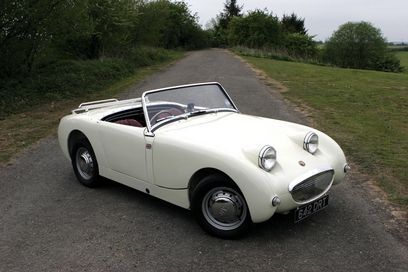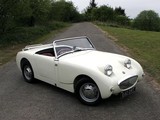
|
 |
| There isn’t much that isn’t available new for the Sprite and Midget, although restoration costs can add up very quickly. |
 |
One of the standard modern-day motoring clichés is the desire for a modern-day Sprite – a synonym for an open-topped two-seater that’s cheap to buy and run. When Austin-Healey launched its ‘Frogeye’ Sprite in May 1958 it cost £679, or not much more than a four-door Morris Minor; this really was fun motoring on the cheap. Thanks to a poverty spec (even bumpers were an extra), both weight and price were kept to a minimum, but values have climbed steadily as restoration costs have soared and the number of decent examples has dwindled; the days of students running these cars on a shoestring disappeared long ago.
Whatever you buy, as long as you don’t pay over the odds you’ll be having a whale of a time. There’s not much than can touch the simplicity and purity of a Frogeye, nearly half a century after it first saw the light of day. However, these cars got more and more complex over time.
The most valuable Spridgets are the Frogeyes, with the Midget 1500 worth the least – all the other derivatives fall pretty much equally in the middle. If you’re handy with the MIG and you want to give your socket set a good airing you’ll be able to buy a project Frogeye for £1500-£2000, but that’ll cost a fair bit in parts and will take a lot of your time to get to a roadworthy condition. If you want something that you can use without having to put any effort in you can pick something up for £4500-£5500. Even the best cars are worth no more than £7500, although some are optimistically advertised for closer to £9000.
Although the Midget 1500 is the best to drive and the easiest to live with – as it’s the most highly developed of them all – the best examples are worth no more than £4000. Projects start at £200, which means a decent, usable car is around £2000. That leaves all the other derivatives, which start at around £500 for a complete project; the best examples fetch around £5000, with good runners around the £2500 mark. Incidentally, although Sprites have more cachet than Midgets, they’re worth no more.
ENGINE
The Frogeye’s engine is based on the A35’s, but with twin SU carburettors instead of a single Zenith, plus stronger bearings, valves and springs. Not many Frogeyes still have their original 948cc engine as most have either bigger units or rebuilt items fitted by now; if you’re after one with an original powerplant, check if the serial number begins with 9C-U-H. That won’t tell you if it’s the original engine (you’ll need a Heritage trace certificate for that), but you can at least tell if it’s the correct version for the car. If your quest is to track down a car that’s original in every respect, make sure the carburettors have brass tops, indicating the correct 1 1/8in versions. Later plastic-topped 1 1/4in units are often substituted.
The A-series engine isn’t known for its ability to retain oil, and if you’re looking at a 948cc version fitted with a scroll-type rear crank seal there’s almost no chance of it being oil-tight. Starting from cold the oil pressure should be 60psi –?once warmed up expect 40psi at 1000rpm. If there’s much less than this you can expect to have to rebuild it before long.
Tappet noise is a part of Sprite ownership, as is a rattling timing chain. If you find the timing chain too noisy a Duplex assembly can be fitted to make it run more quietly. A loud rattle when starting probably comes from a fractured carburettor heat shield; over-enthusiastic tightening can break the rear lug on the manifold.
The A-series engine isn’t durable, but it will take hard use without complaint. In 948cc form a set of big end shells may last just 40,000 miles and 1275cc versions will probably suffer from worn piston rings and bores by the time 70,000 miles have been racked up. To check for the early stages of this, run the engine with the oil filler cap removed. If any fumes are evident it’ll be time for a rebore before long.
Check for a white emulsion on the oil filler cap on 1275cc engines, which are prone to failed head gaskets. Many cars are fitted with electric fuel pumps, most of which were fitted in the 1980s when the correct mechanical pumps were hard to source. It’s now possible to get the right bits again, so returning the car to original specification is easy.
The crankshaft of the 1493cc engine can wear badly, as can the pistons and rings. Listen out for rattling when starting up and look for blue smoke as you accelerate through the gears, indicating that the engine has worn. If these symptoms are present, your best bet is to source an exchange rebuilt unit, for which you’ll pay around £1100.
TRANSMISSION
The MkI Sprite’s gearbox and back axle are the same as those used in the A35. There’s syncro on second, third and fourth, although early gearboxes had rather weak syncromesh on second gear. Original cars will have a smooth gearbox casing (visible down the back of the engine), which is often substituted for the later ribbed version, offering greater strength and improved syncromesh.
If the gearbox is getting worn it’ll jump out of gear while you’re giving it a test drive – rebuilding the gearbox costs around £200 if you do it yourself. Having it done by a specialist will cost closer to £600.
Halfshafts of early cars are prone to breaking, and with engine upgrades being popular they have an even harder time. A lack of soundproofing makes it easy to hear whines and knocks from the halfshaft splines once they begin to wear.
SUSPENSION, STEERING AND BRAKES
Front suspension is A35-sourced, but the rack and pinion steering is borrowed from the Minor. If it doesn’t feel really precise there’s a problem – the steering should be light and positive. If it isn’t, the chances are the suspension hasn’t been greased regularly.
The front trunnions should have been greased every three months to prevent premature wear. Kingpins are also prone to wear through a lack of regular greasing, so make sure they’ve been done at the same time. To check if a rebuild is due, jack up the front of the car by supporting it under the front crossmember, and grip the road wheel at top and bottom. Try to rock it –?if there’s any play it may indicate kingpin wear. To be certain, get somebody to apply the footbrake while you repeat the process. If it’s ‘cured’ a new wheel bearing is needed – if there’s still play the kingpin bushes or lower links (fulcrum pins) are due for replacement.
The front lever arm dampers lose their effectiveness very quickly, so check them by bouncing each front corner. The rears are far more durable. Some cars have had a telescopic damper conversion, which is quite involved. The end result doesn’t feel any better, but the replacement dampers will be much more durable than the original lever arm units.
Drum brakes were fitted all round on the Frogeye, and these are perfectly adequate for the car’s performance. Fronts were taken from the A35 and rears from the Minor. Pedal pressures are a bit higher than with a disc/drum set up, but there should be plenty of feel through the pedal.
Later Sprites used disc brakes at the front; these can also be fitted to the Frogeye. If the swap has already been made make sure the master cylinder from a later Sprite (MkIII/IV) has been fitted, otherwise the brake pedal will require an even greater pressure to pull the car up.
Another complication is the fact that the master cylinder is a dual item, controlling both the brake and clutch hydraulic systems. Check the braking efficiency and look for leaks around the master cylinder, because if one of the bores is damaged or worn you’ll probably have to scrap the whole unit and replace it with a new one – at £230.
CONCLUSION
Where early cars are concerned, originality is important, so don’t consider making major modifications unless they can be reversed or you’re prepared to make a loss when selling on. The exception to this is under the bonnet – a larger capacity powerplant is okay as long as it’s an A-series and is joined by uprated brakes. It’s worth knowing if any changes to the car are period or not – contemporary tweaks can be quite desirable – but later ones won’t be in keeping. Tuned cars by companies such as Speedwell or Downton aren’t worth much more than standard cars, but they’re worth tracking down just for their rarity.
There isn’t much that isn’t available new for the Sprite and Midget, although restoration costs can add up very quickly. What isn’t available new is generally available second-hand. The simple construction of the car allows an easy inspection to be made before parting with your cash, so there’s really no excuse if you get caught out. Running costs are also very low –?so what are you waiting for?
[cite]
|















